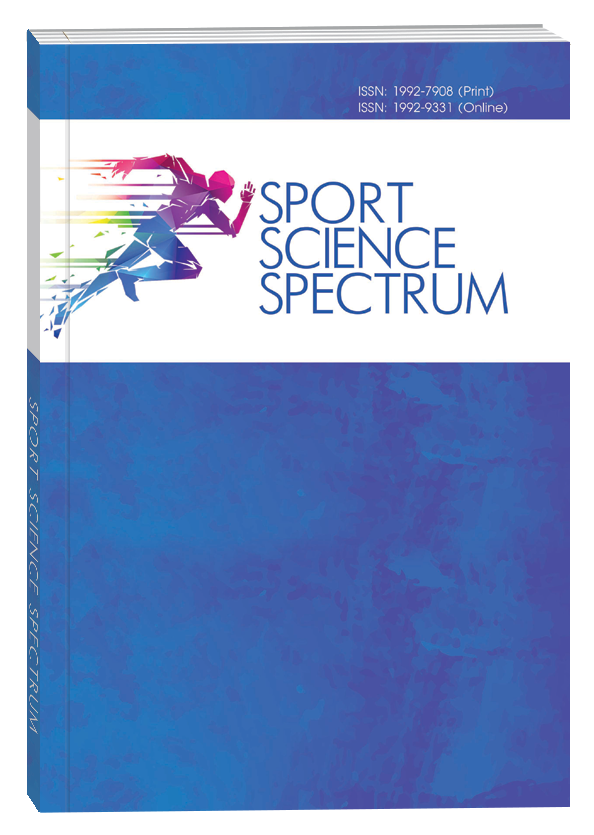STAGES OF THE ANNUAL TRAINING CYCLE – THE BASIS FOR IMPROVING PHYSICAL QUALITIES TO ENSURE THE PERFORMANCE OF MIDDLE-DISTANCE RUNNERS AT THE STAGE OF SPECIALIZED BASIC PREPARATION
DOI:
https://doi.org/10.32782/spectrum/2024-3-2Keywords:
track and field, middle distance running, stage of specialized basic training, intensity zone, exercises, physical qualities, functional capabilities, annual cycle stages, periodization system, tasks of the annual cycle stagesAbstract
Introduction. The groups of exercises of different predominant orientations being the foundation for physical quality formation (general and special endurance, speed, speed-strength qualities, agility, flexibility) at the stage of specialized basic training were developed. It is based on the annual training macrocycle of middle-distance runners of this stage, which includes 2 macrocycles: fall-winter and spring-summer, 6 main periods, and 16 stages of preparation involving 18 mesocycles and 52 microcycles. The objective of the study was to improve the methodology of physical quality formation in middle-distance runners through the use of training means of different predominant orientations on the basis of solving the set tasks of the main stages of preparation of the third year of training of the specialized basic preparation stage. Methods of study: analysis of scientific and methodological literature and generalization of best practices (questionnaires, interviews) of endurance running coaches (middle and long distances), protocols, and calendar of competitions. Results of the study. Taking into account the calendar of competitions and the annual training macrocycle of a group of skilled middle-distance runners of the third year of training at the stage of specialized basic preparation, the tasks of the annual cycle stages were developed. The tasks of the 16 stages of the annual cycle are based on exercises of different predominant orientations, methods of their usage with account for the five zones of intensity. In the process of preparation, it will help to determine the structure and content of training of middle-distance runners at the stage of the specialized basic preparation and bring them to the peak of sports form during the major competitions. Conclusions. The training process of middle-distance runners should include exercises of different predominant orientations aimed at developing general and special endurance, speed, speed-strength qualities, static and dynamic balance, agility, and flexibility. This will allow them to successfully perform large volumes of special work, better tolerate loads, faster recover, get fit in due time, and demonstrate physical, technical, tactical, and mental fitness to achieve high sports results in extreme conditions of competitive activity.
References
1. Alcaraz P., Palao J., Elvira J. Determining the optimal load for resisted sprint training with sled towing. Journal Strength Cond Res. 2009. no. 23. P. 480–485.
2. Athletics: curriculum for children’s and youth sports schools, specialized children’s and youth sports schools of the Olympic reserve, schools of higher sportsmanship and specialized educational institutions of the sports profile / editor V.I. Bobrovnyk, S.P. Sovenko, A.V. Kolot. Kyiv : Logos, 2019. 191 p.
3. Athletics: theory and coaching methods: textbook: in 2 books / editor V.I. Bobrovnyk, S.P. Sovenko, A.V. Kolot. Кyiv : Оlympic Literature Publishing House, 2023. Vol. 1. 712 p.; Vol. 2, 608 p.
4. Bobrovnyk V.І., Тkachenko М.L., Puhachov D.О., Коlot А.V. Аnalysis of athletes’ performances at the Olympic Games and World Championships from 2008 to 2023 in middle distance running (800, 1500 m). Scientific journal of M.P. Drahomanov National Pedagogical University. Series 15. Scientific and pedagogical problems of physical culture (physical culture and sports). 2023. no. 12(172). P. 28–41. URL: https://doi.org/10.31392/UDU-nc.series15.2023.12(172).05 (date of access: 21.12.2023).
5. Bobrovnyk V.І., Puhachov D.О., Тkachenko М.L. Тraining means of different orientations to improve physical qualities of middle distance runners at the stage of specialized basic preparation. Тhеоry and methods of physical education and sport. 2023. no. 4. P. 3–12. URL: https://doi.org/10.32652/tmfvs.2023.4.3-12 (date of access: 07.01.2024).
6. De Villarreal E.S., González-Badillo J.J., Izquierdo M. Low and moderate plyometric training frequency produces greater jumping and sprinting gains compared with high frequency. Journal Strength Cond Res. 2008. no. 22. P. 715–725.
7. Dintiman G.B., Ward R.D. Sports Speed (3rd ed). Champaign, IL : Human Kinetics. 2003. no. 3. P. 16, 69, 73, 97, 98, 142, 184, 189.
8. Faccioni A. Assisted and resisted methods for speed development: Part 1. Mod Athlete Coach. 1994. no. 32. P. 3–5.
9. Faccioni A. Assisted and resisted methods for speed development: Part 2. Mod Athlete Coach. 1994. no. 32. P. 8–12.
10. Internet link to the calendar of competitions of the Athletics Federation of Europe. URL: https://www.european-athletics.com/home/calendar
11. Internet link to the calendar of competitions of the Athletics Federation of Kyiv. URL: https://fla-kyiv.org.ua /календар-2024/
12. Internet link to the calendar of competitions of the Athletics Federation of Ukraine. URL: https://uaf.org.ua/calendar-flau/
13. Internet link to the calendar of competitions of the International Association of Athletics Federations. URL: https://worldathletics.org/competition/calendar-results
14. Klinzing J. Improving sprint speed for all athletes. Natl Strength Cond Asso Journal. 1984. no. 6. P. 32–33.
15. Letzetter M., Sauerwein G., Burger R. Resistance runs in speed development. Mod Athlete Coach. 1995. no. 33. P. 7–12.
16. Mero A., Komi P. V. Effects of supramaximal velocity on biomechanical variables in sprinting. Int Journal Sport Biomech. 1985. no. 1. P. 240–252.
17. Platonov V.М. Modern system of sports training. Кyiv : Persha drukarnia, 2021. 672 p.
18. Radcliffe J.C., Farentinos R.C. High-Powered Plyometrics. Champaign, IL : Human Kinetics, 1999. no. 2. P. 23–36.
19. Rimmer E., Sleivert G. Effects of a plyometrics intervention program on sprint performance. Journal Strength Cond Res. 2000. no. 14. P. 295–301.
20. Young W. B. Transfer of strength and power training to sports performance. Int Journal Sports Physiol Perform. 2006. no. 1. P. 74–83.





